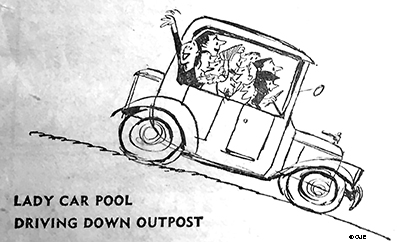Note from Linda: At the time of this article, February 7, 1957, the lead-in stated the following: “Chuck Jones has been Art Director of the Crier from its infancy, and herein tells you how come. He and Dottie dwell in a fabulous glass-and-stone aerie up in Hollywood Knolls, and Little Linda is all grown up and married.” I was, as stated in the article, seven years old in 1944. I well remember my father’s “war warden” hard hat…with a webbing inside that fascinated me…but he wouldn’t let me play with it. He went out almost every night, from our blacked out home, with his huge flashlight and his hard hat and a first aid kit slung over his chest. The searchlights interspersed the stars…and they were not for movie openings, but searching for enemy aircraft. Here is Part IV.[PART IV] The Oddments of War
Thus she joined the carpool and the “Canyon Crier” became a factor in our lives. We were at about this time promoted to a kind of restricted B sticker for our gasoline ration I was working on a project to camouflage Signal Hill rather a thankless job since the oil wells could only be disguised as something that looked like another military objective like a ship yard, an ammunition dump or an air-field. I think our final suggestion was to build two other fake Signal Hillses and hope for the best, or to make a gigantic tent big enough to cover all of Long Beach. At any rate we managed to carry on, although I occasionally had to employ the steps, dare the dog, and the Rhus diversiloba (poison oak).
It was through the tiny pages of the Crier that we were informed of the activities of Civilian Defense. Dan Duryea, as I remember it, was Senior Warden in our parts. Ken Harris was block Warden. Kent Winthers was Junior Warden and I was Fire Watcher, since we were almost the sole residents of Passmore Drive at that time. The Finkel house, now owned and beautifully remodeled by Hal and Margo Findlay, was then empty and the only other house was occupied, I believe, by a schizophrenic who thought he was a German spy but never came outdoors long enough to find out. He it was who had bought the confused Doberman thinking him to be a turn=coat (or turn-pelt). The three of us then were the task force that manned Operation Passmore, and even though in the giant logistics of war such minutia are often overlooked, yet it is true that we kept Passmore Drive remarkably free of fire-bombs.
[See you next week, with Part V]




